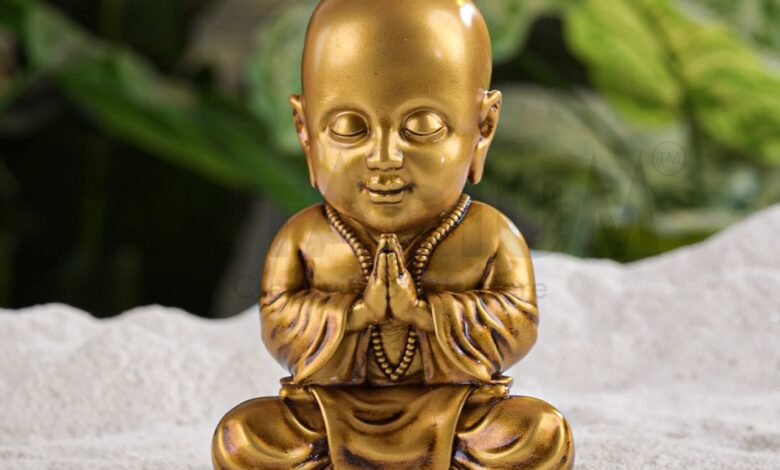
Introduction
Child Buddha statues, also known as Bal Vihar or Juwelas, have been captivating the hearts and minds of people worldwide for centuries. These intricately designed sculptures depict Buddha in his early years, often as a young prince, before he attained enlightenment and became the Buddha we know today. These enchanting artworks serve as a reminder of the importance of compassion, wisdom, and spiritual growth at any stage of life. In this post, we will delve into the history, symbolism, significance, and cultural impact of Child Buddha statues, as well as explore their role in contemporary spiritual practices and art collections.
-
Historical Context and Origins
The origins of Child Buddha statues can be traced back to ancient India, where they first emerged during the Pala and Sena dynasties (circa 7th to 12th centuries CE). These sculptures were primarily created in the Indian states of Bihar, Bengal, and Orissa, which were cultural and artistic hubs during this period. The Pala and Sena artists were inspired by the earlier Gupta period (circa 4th to 6th centuries CE) and the Gandhara Greco-Buddhist art, which combined Indian and Hellenistic styles.
-
Symbolism and Meanings
Child Buddha statues often depict the young prince Siddhartha Gautama, who would later become the historical Buddha. These sculptures typically showcase the future Buddha in various activities, such as playing, meditating, or being attended to by his nanny. The symbolism in these artworks is multifaceted, as they convey several key messages:
- Innocence and Purity: The young prince’s serene and innocent demeanor signifies the purity of his intentions and his inherent potential for spiritual growth.
- Human Connection: By portraying Buddha as a child, these statues emphasize his relatability and humanity, making it easier for people to connect with him emotionally and spiritually.
- The Path to Enlightenment: Child Buddha statues remind us that spiritual awakening is a lifelong journey, even starting from one’s early years.
-
Artistic Styles and Techniques
Child Buddha statues have been crafted in various materials, including stone, bronze, wood, and terracotta. The most renowned examples are the stone sculptures from the Pala and Sena periods, which are characterized by their exquisite craftsmanship, attention to detail, and emotive expressions. These statues often exhibit the following artistic styles:
- Mahayana Buddhist Iconography: The unique iconography of Child Buddha statues is deeply rooted in Mahayana Buddhist traditions, which emphasize the importance of compassion and the bodhisattva path.
- Amoghapasa Mudra: Many Child Buddha statues depict the future Buddha in the act of making the Amoghapasa (inconceivable) mudra, symbolizing his future mastery of the Dharma.
- Sculptural Techniques: The artists of the Pala and Sena periods employed various techniques, such as drilling, carving, and polishing, to create lifelike and expressive statues.
-
Cultural Impact and Significance
Child Buddha statues have played a crucial role in the cultural and spiritual life of Buddhist societies. They have been featured in temples, monasteries, and household shrines, serving as focal points for devotion, meditation, and contemplation. These statues have also inspired numerous literary works, such as Buddhist scriptures, poems, and hymns, which further enrich our understanding of their significance.
-
Contemporary Relevance and Appreciation
In the modern era, Child Buddha statues continue to captivate collectors, art enthusiasts, and spiritual seekers alike. These sculptures are not only valued for their aesthetic appeal but also for the profound messages they convey about human potential, spiritual growth, and the interconnectedness of all life.
The Historical Context
The origins of Child Buddha statues can be traced back to the early centuries of Buddhism, specifically during the Gupta period (4th to 6th centuries CE) in India. These sculptures were primarily found in the Gandhara region, which is now a part of modern-day Pakistan and Afghanistan. The artistic style of these early Child Buddha statues was heavily influenced by the Greco-Buddhist art, which combined the Hellenistic artistic traditions with Buddhist themes.
As Buddhism spread across Asia, the depiction of the Child Buddha evolved, adopting various regional styles and artistic influences. In China, for instance, the Child Buddha statues were often depicted in a more chubby and playful manner, reflecting the Chinese aesthetic sensibilities. In Southeast Asia, particularly in Thailand and Cambodia, the Child Buddha statues were incorporated into the grandeur of Khmer and Angkorian art, showcasing their divine connection with the universe.
The Significance of Child Buddha Statues
Child Buddha statues hold immense spiritual and cultural significance in Buddhism. They serve as a reminder of the Buddha’s humble beginnings and his journey towards enlightenment. The portrayal of the Buddha as a child symbolizes his innate purity, wisdom, and compassion, which were present even before he attained full spiritual realization.
Furthermore, these statues represent the potential for spiritual growth and transformation within each individual. By contemplating the innocence and purity of the Child Buddha, devotees are encouraged to cultivate similar qualities within themselves, fostering a deeper connection with their spiritual path.
Artistic Styles and Techniques
Child Buddha statues have been crafted in various materials, including stone, bronze, wood, and terracotta. The choice of material and the level of detail in the sculptures often depended on the cultural and artistic traditions of the region where they were created.
One of the most notable artistic styles associated with Child Buddha statues is the Gandhara school, which was characterized by its elegant proportions, graceful poses, and the incorporation of Greco-Roman elements such as drapery and hairstyles. The Bamiyan Buddhas in Afghanistan, though now destroyed, were prime examples of the Gandharian style.
In conclusion, the allure of Child Buddha statues lies in their ability to evoke a sense of wonder, compassion, and inspiration. These enchanting artworks serve as a reminder that spiritual awakening is a lifelong journey, and that even in our earliest years, we possess the innate potential for enlightenment. As we continue to appreciate and learn from these timeless masterpieces, we deepen our understanding of Buddhist teachings and the human condition, fostering a more compassionate and interconnected world.



